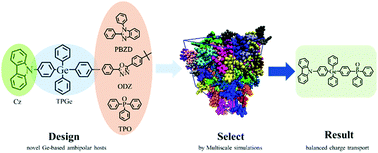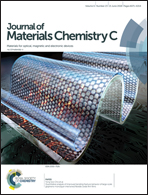Ge-based bipolar small molecular host for highly efficient blue OLEDs: multiscale simulation of charge transport
Abstract
Bipolar host materials can achieve excellent charge-transport balance and enhance device performance in phosphorescent organic light-emitting diodes (PhOLEDs). In this work, we designed three Ge-based bipolar host materials, (4-((4-(9H-carbazol-9-yl)phenyl)diphenylgermyl)phenyl)diphenylphosphine oxide (CzGeTpo), 2-(4-((4-(9H-carbazol-9-yl)phenyl)diphenylgermyl) phenyl)-5-(4-(tert-butyl)phenyl)-1,3,4-oxadiazole (CzGeOdz), and 9-(4-(diphenyl(4-(1-phenyl-1H-benzo[d]imidazol-2-yl)phenyl)germyl)phenyl)-9H-carbazole (CzGePbzd), for blue PhOLEDs. These Ge-based bipolar hosts incorporate both the electron-donating group and electron-withdrawing group into the Ge-based core moiety (tetraphenylgermane) at the same time. The frontier molecular orbital energy levels of these materials suggest that all these Ge-based hosts are not only facilitated to obtain holes but also electrons. A multiscale simulation of charge transport in the amorphous thin film was developed to investigate the charge-transport properties of these materials. The simulation was based on quantum chemical calculations, molecular dynamics simulations, and Monte Carlo calculations. The results showed that all these materials exhibited both good electron and hole transport properties. CzGeTpo showed balanced charge-transport properties with a hole/electron ratio of 8 (the electron and hole mobilities were 1.6 × 10−3 and 1.2 × 10−2 cm2 V−1 s−1, respectively). At the same time, the lowest triplet energy of CzGeTpo was 3.31 eV, which is higher than that of most blue phosphorescent materials. The findings suggest that CzGeTpo would be a promising candidate for Ge-based bipolar small molecular hosts for highly efficient blue PhOLEDs.

- This article is part of the themed collection: 2018 Journal of Materials Chemistry C HOT Papers


 Please wait while we load your content...
Please wait while we load your content...